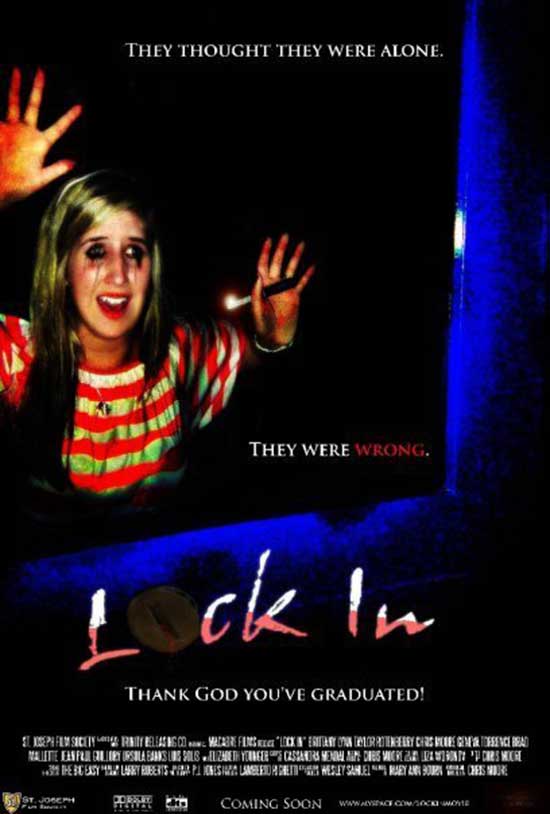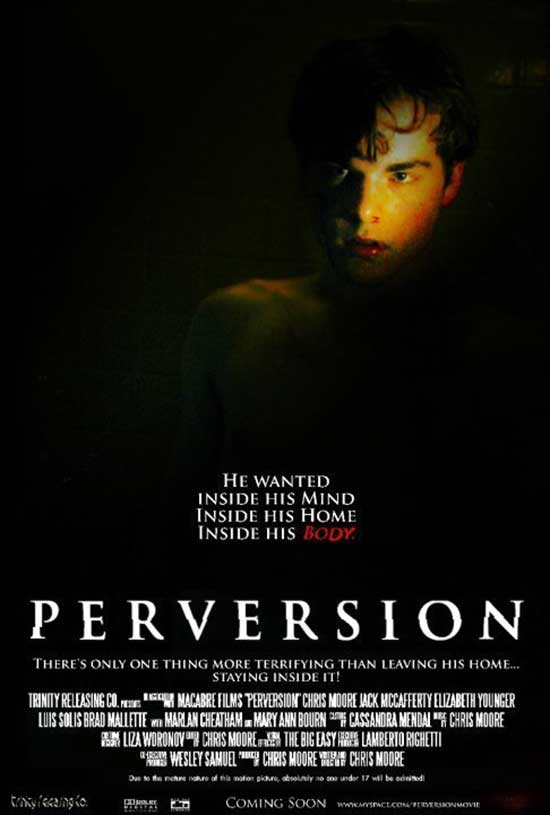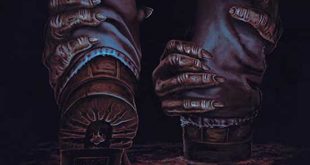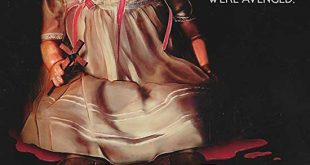From Sondheim to Serial Killers, The Wild Rise of an Indie Auteur: An Interview
with Actor, Writer, Director and All-Around Horror Fan Christopher Wesley Moore
It’s easy to discuss every aspect of horror and fantasy output from the major studios and to assume that the survivability of the genre lies with the big boys. In reality, what drives horror from a creativity standpoint are all the independent talents and companies who remain unnoticed in the shadow of the Universals, Paramounts, and other giants. So when an opportunity comes for me to bring to light a gifted artist or company, I leap it with the ferocity of a starving werewolf attack. I’d become familiar with the work of Christopher Wesley Moore after reading issue 11 of Ultra Violent magazine and Michael Varrati’s discussion of the twisted spin on Agoraphobia and mental instability with the Moore-helmed Perversion from 2010. Wearing three hats as director, writer, and star, Moore really shows a passion for the psycho creepshow and a knack for showing a vulnerable type, in this case a teen, wreaked by phobia. It kind of left a most distinct imprint on me even those 8 years ago. I am pleased that he accepted my request for interview. Without further adieu….
KN: In researching your career, I found that we have two major things in common, a love for Musical Theatre and the fact that our dads were an important part of our beginnings in horror fandom. First, how does someone with a background in Stephen Sondheim musicals (your role of John Hinckley is one of my favorites in the show. I have Unworthy of Your Love going through my head right now) and Cole Porter (Moonface Martin is kind of fun in Anything Goes) segue into the deep and disturbing areas of the chiller genre that you now travel through? Second, please elaborate on the role your dad played in forming your horror interests?
CM: They seem like such polar opposites, don’t they? The truth is – I loved musicals as a kid. The Sound of Music, Grease, Rogers and Hammerstein’s Cinderella (with Lesley Ann Warren), The King and I, etc. I even loved these musical fairy tales called Cannon Movie Tales that featured big stars singing and dancing their way through classic fairy tales. I remember the best one being Snow White starring Diana Rigg as the evil queen. That performance might be when I first realized I wanted to be an entertainer of some sort. I was genuinely obsessed with fairy tales, too, and the darker, the better. Fairy tales probably have much more in common with horror films than one would think. Certainly, my family didn’t think they had anything in common. I think that’s why my Dad set me down one Sunday morning to watch House of Wax (the 1953 version with Vincent Price) on A&E. I think he was scared I’d become too soft if I kept watching musicals and obsessing about fairy tales. Little did he know I liked fairy tales mostly for the villains, not the princesses. I must have been 5 or 6 and House of Wax was the perfect gateway into the horror genre. It’s just macabre and creepy enough for a kid to go “woah! This is unlike anything I’ve ever seen.” I was so glad he sat me down to watch it.
After a little while, I started becoming really interested in horror and I had this desire to be considered an adult, so I put away the fairy tales and musicals for years and seemed to only watch horror films, which was quite a feat in those early internet days. I’d have to check the TV guide every week to see if there were any playing on networks like USA, TNT, or TBS because that’s the only way I was allowed to watch them for awhile. They’d usually cut all the R rated stuff out. I don’t think I was allowed to watch R rated movies until I was 8 and convinced my Mom that all my classmates were watching them and that I’d be uncool if I wasn’t allowed to.
That’s sorta how I rolled for awhile until 7th or 8th grade and I was at a friend’s house and he had a copy of that Diana Rigg Snow White, which I hadn’t seen for years. I made a copy of it and managed to track down all the other Cannon Movie Tales as well. This was right around the time I was starting to make movies and I’d just tried to make a Scream fan film called Killer, so I switched to the idea of making a dark fairy tale next.
Around the same time, my interest in musicals returned when I saw my school’s production of Bye, Bye Birdie. I remember watching it and thinking “boy, that looks like fun! I want to do that.” I eventually did a few school musicals in my day like Mame, Anything Goes, and Into the Woods. Into the Woods is what introduced me to the genius of Stephen Sondheim and that was like discovering another language. All of a sudden, musicals could be about adults and adult issues and didn’t always have to be random chorus girls bursting out into song for no reason. Discovering Sondheim was the first time singing seemed as natural as breathing.
KN: My first baby steps into viewing scary movies came from when my dad would watch the late horror show here in San Jose, California, and I sneek out of bed to join him. Mom was the worrier that I would get nightmares. Dad enjoyed bonding with me. Well, I’d run screaming from the opening credits sequence, which showed a vampire running from Blacula. From a previous conversation we had, yours came from glancing at a movie poster at the cinema? Can you talk about that for a bit?
CM: I remember going to see The Swan Princess in – when was that? 94? 95? Anyway, Mary Shelley’s Frankenstein was playing in the same theater and I was terrified that we’d accidentally go into that auditorium instead. I’m not sure why I thought this since my parents could read and weren’t total idiots, but kids are funny creatures. I’d seen the TV spots and posters for it and it looked terrifying to a little kid. As a kid, I was terrified of horror films. Really anything that had scary scenes. Some of my most vivid memories are walking up and down the horror aisle of our local video stores and looking at all the box art. I’d look at the pictures on the back (some of which, I’m shocked they got away with showing) and making up my own version of what was contained inside the cassette. When I saw most of these films later in life, none of them could compare with the stories I cooked up in my imagination. I’d have the worst nightmares. There were always witches and demons and ghouls trying to get to me. Funnily enough, after I started watching horror films, the nightmares went away completely. It must be a great way of exorcising demons.
 KN: Your first foray, 2007’s Lock In, seems to be in the same subgenre school slasher vein as movies like Prom Night (1980 and 2008), the original House on Sorority Row from 82, and perhaps a bit from Massacre at Central High. Even the perpetrator being someone from the dark past of the town draws thoughts of Freddy Krueger and the Nightmare on Elm Street series. Were these elements an inspiration for you in making this or was it something else?
KN: Your first foray, 2007’s Lock In, seems to be in the same subgenre school slasher vein as movies like Prom Night (1980 and 2008), the original House on Sorority Row from 82, and perhaps a bit from Massacre at Central High. Even the perpetrator being someone from the dark past of the town draws thoughts of Freddy Krueger and the Nightmare on Elm Street series. Were these elements an inspiration for you in making this or was it something else?
CM: Lock In was just a blast. I made it for our school film society. We’d done a little spoof of High School Musical a few months before for homecoming and, our wonderful faculty advisor, suggested that we do something for Halloween. It was definitely inspired by some of those early 80’s slashers. Prom Night and The Initiation come to mind as two of the biggest inspirations. I’d been writing a script called Lock In that was originally supposed to take place in one of those big, indoor playgrounds (like a Chuck-E-Cheese or Discovery Zone on crack) and I thought I could switch the location to a high school on senior prank night. I don’t think the script was half bad, but had to keep cutting chunks out because the actors would have other commitments like sports practice or band practice or they’d have to study for a big test, so we’d either give their lines to someone else, cut scenes, or even cut characters completely. Because of that, it became a bit of a mess, but we had free reign of our high school after hours and on the weekends, which was like a dream. We were trying to get it out by Halloween, but it wasn’t finished yet and, I recall, the last day of filming was the day we got out for Thanksgiving break. I edited the film during that break and we had a screening on a Saturday night in December inside the school library. It was such a thrill to hear the students scream and laugh and have such a great time with it. Come to think of it – how the hell did we get away with shooting a school sponsored slasher film? I guess the tone was so silly and wonky that they figured it was no big deal.
KN: Next in line was a jaunt into Brothers Grimm territory with Gingerdead: The Adventures of Nella and Nello short in 2010. A variation on the Hansel and Gretel fairy tale. You were once quoted as saying you had very little interest in Disney fairy tales due to their being too “glossy, sugary” and that you admired the Grimm tales for their villains. Please explain the genesis behind how this short came about and your interest in the story.
CM: Oh, boy! That was a school project for a college class my best friend and I were taking about fairy tales. Gingerdead was a re-telling of Hansel and Gretel in post-Katrina New Orleans. It was really fun. We both played multiple roles. The most I remember about that was finishing the script when I was back home getting ready for my father’s funeral. Even then, I had a “show must go on” mentality. I remember our teacher e-mailing me and saying that, because of the recent circumstances, I could be excused from the project or do something different, but I probably needed something to distract me during that time. I got back there and we started filming it and I really was glad to have that to take my mind off of everything. Hansel and Gretel was always one of my favorite stories and it really is one of the most horror-esque of the classic fairy tales. I mean, it’s about a lady who lives in the woods who likes to eat children for God’s sake. Pretty dark stuff. It’s not too far removed from something like The Texas Chainsaw Massacre if you really stop and think about it.
KN: With a $10,000 budget, you were still able to shoot on location in North Carolina. These location filmings can either be difficult as hell or a smooth experience, I understand, with little of in-the-middle reactions. How did it go for you?
CM: That budget is being super generous. That might have been the first thing I ever put on IMDB and I tried to say its budget was $200 (which was closer to the truth) and they wouldn’t accept it as it seemed “too low.” We spent nothing on that movie. Maybe a quick trip to Goodwill for costumes and a trip to Party City for fake blood and that was about it. I do remember shooting in this abandoned warehouse close to campus that was really creepy and, of course, we didn’t have permission to be there. We didn’t think about stuff like that. We knew we weren’t going to break stuff or leave it in worse shape than it already was. We were more scared of crack heads popping out and trying to rape and murder us. I remember the shoot being fairly smooth. Maybe a few days long at the most.
 KN: This was followed up with the delightfully tormented and bent turn as Ryan McNamara and the freshly twisted Perversion the same year. You nail phobias and psychosis nicely here. You’ve also been quoted as saying Psycho and House of Wax were your intros to horror as a 5-6 year old child. Were you able to draw from certain influences such as Norman Bates for your role here, or did it come from elsewhere?
KN: This was followed up with the delightfully tormented and bent turn as Ryan McNamara and the freshly twisted Perversion the same year. You nail phobias and psychosis nicely here. You’ve also been quoted as saying Psycho and House of Wax were your intros to horror as a 5-6 year old child. Were you able to draw from certain influences such as Norman Bates for your role here, or did it come from elsewhere?
CM: Perversion was actually shot mostly in the summer of 2008 and a little bit in 2009. It was finished and released later on. I’d just made Lock In and I wanted to do something really psychological and creepy. I thought it was very adult and daring. I always thought of it like a gender reversed Repulsion. I vividly recall going into production without an ending, which is always terrifying and remarkably stupid. It’s not a movie people usually want to see a 2nd time. It was a tough shoot emotionally and physically and I haven’t done anything else quite like it since. It’s been on my mind recently, because I think, at some point down the road, it might be a decent candidate for a remake. I did the best with what was given to me at the time. It was shot on DV and, for some reason, those cameras devoured light.We had to shoot every scene with 20 lights on just so you could see anything and it still looked like it was shot in a cave. It was the damndest thing. I did like a lot of elements of the script, though, and my performance isn’t awful I guess. Enough people seemed to like it (despite its limitations) to lead me to believe that I was on to something, so that kept me going and trying to get better and better.
KN: Have to ask about the web-series with the most cheesy fun title I’ve ever read, Confessions of a Horror Baby. I understand that this was a 6 episode web series, lasting two seasons. Viewing the bumper promo before taking a spin with some of the episodes themselves, I’ve never seen crooner-style music meshed so nicely with exploitation sleaze! Your opening disclaimer of “The following program is made possible by the support of truly f*@ked up viewers like you” should’ve been the big clue for me. That and the fact that you pick the acid-trip feeling Horror House on Highway 5 as your first review. Was this an attempt by yourself to turn the usually static and deadly dull review show on its ear?
CM: Horror Baby happened when I was experiencing a creative funk. I was in college, studying filmmaking, and nothing I was doing seemed to work or was good enough. I wasn’t able to make the kinds of movies the professors wanted to see (film festival bait usually) and I wanted to have an outlet to have a little fun. I thought of it as a mash up of Elvira, Monstervision, and The Soup. There were little musical numbers and asides. It was a lot of fun, but SO much work. I think I did it during the summer in between semesters of college. What’s most rewarding is when people message me on Facebook or Instagram and say “y’know, I watched (such and such) film because you reviewed it on Horror Baby and it’s now one of my favorite movies.” That really makes me happy. It was always my goal to try and point out the good even in something as off the wall and nutty as Horror House on Highway 5. There were plans to do a season 3, but life got in the way. Every now and then, I get asked to do a new episode, so never say never.
KN: The idea that you would have characters named Dick and Lorraine Bobbitt, and have them as homeless country and western scatters of all people for the American Dream short, definitely shows a skewed sense of humor on your part. Was this an entry for you into the absurdist or the anti-normal side of pursuing one’s calling?
CM: The American Dream was a short my friend, Nina Scholl, and I came up with for one of her classes. I think it might have been a visual storytelling class. Everyone usually did boring PowerPoint-esque presentations and Nina said “why don’t we actually go out and film something?” Being in said creative funk at the time, I was more than happy to. We started getting random nature and atmosphere footage and, somewhere, in the car ride, we started discussing the kinds of people who’d live in this house or that house or those apartments and we came up with the idea for these two characters, Dick and Lorraine Bobbit. The original short was about them living out of their car, still having the dream to be country western jazz scatters. Nina really brought out the more absurd side of me – a side I didn’t even know that I had. I think all of that film was improvisation. We just play so well off of one another. The short was a big hit in her class and it lead us to think there might be more to this than we’d originally thought.
Read More at: Interview: Christopher Wesley Moore – Part 2
 Horror News | HNN Official Site | Horror Movies,Trailers, Reviews
Horror News | HNN Official Site | Horror Movies,Trailers, Reviews

